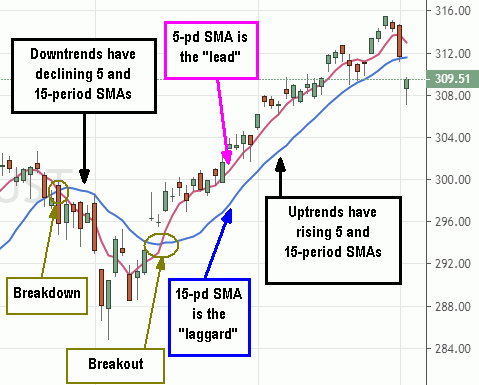One of the most overused axioms in trading is “The trend is your friend.” This rearview mirror piece of conventional wisdom would suggest that you should be trading in the direction of the (price) trend, not against it. This advice assumes the trader actually knows the direction of the trend. There are two types of price trends, uptrends (prices continue to rise) and downtrends (prices continue to fall). While many chartists prefer to draw static trend lines to identify trends, I’ve found this simple chart indicator to be a most useful tool for visually monitoring and quantifying a price trend on-the-fly for any stock. It is a simple moving average (SMA).

The Simple Moving Average
There are many variations of the moving average line, but the simple moving average is the most commonly found on any charting platform. It plots a continuous line representing the average price of all trades made within a specified period of time. Therefore, a five-period SMA on a 15-minute chart represents the average price of all the trades executed in a 75-minute window of time. Users can adjust the parameters by choosing the number of periods along with the chart time frame. Higher periods and/or chart time frames entail a wider range of prices which may generate an SMA line that may be far away from where the stock is currently trading. Smaller time frames will result in SMA lines trading closer to the current stock price. Intraday traders favor smaller time frames like the one, five, 15 and 60-minute charts while swing traders and investors prefer larger time frames like the daily, weekly and monthly charts.
Using Five and 15-period SMAs for Trends
We like to use two SMAs composed of a five-period and 15-period. This provides a “lead” and a “laggard” moving average. The five-period SMA is the first support of the trend and the 15-period SMA is the second support. Uptrends have risen five and 15-period SMAs. Downtrends have declining five and 15-period SMAs. Active trends will deflect off the five-period SMA support. When a price trend starts to exhaust, it will breach the five-period SMA and test or break the 15-period SMA, then coil back to the five-period SMA in ping pong fashion until either the five-period or 15-period SMA “breaks” to form another leg in the same trend or reverse the trend via SMA crossover.
Breakouts and Breakdowns
SMA crossovers indicate price trend reversal breakouts and breakdowns. A breakout precedes an uptrend and is illustrated by the five-period SMA crossing up through the 15-period SMA. A breakdown precedes a downtrend illustrated by the five-period SMA crossing down through the 15-period SMA.
Three Ways to Trade the Trends with SMAs
To properly use the SMAs, select the preferred time frame charts (smaller time frames for intraday or wider time frames for swing trading). The SMAs will illustrate the direction of the trend (uptrend or downtrend) as well as the supports (five-period SMA and 15-period SMA). There are three ways to trade an active price trend:
- Trading with the trend as your “friend” entails taking pullback entries at the five-period SMA support with stops under the 15-period SMA.
- Trading a countertrend reversion entails entering at “exhaustion” price levels and targeting exits at or near the five or 15-period SMAs.
- Trading a trend reversal entails catching the break-out/down at the point of the five-period SMA crossover through the 15-period SMA. Usually, the second rejection of the five-period SMA just after the crossover is the sweet spot for entry.
Nuances
It’s important to make sure there is an active trend in place when taking trend-based trades. When the SMAs are sideways or are choppy (constant crossovers in a small range), it’s best to wait it out. A good way to gauge if price action is worth trading is to measure the price range between the five-period SMA and 15-period SMA. A larger price range means there’s more “meat on the bones” to trade a trend reversal or channel tightening reversion, capturing the gap between the five and 15-period SMAs.
Avengers Assemble
The SMAs are a price indicator tool. Proper timing requires a momentum tool, such as the stochastic oscillator. By combining the stochastic oscillator for entries and SMAs for price support/resistance targets, traders can start to develop a methodology that is dynamic, robust and self-calibrating. Just like the Marvel Avengers, each individual has specific superpowers making their formidable on their own, but the cumulative effect as a group using their powers in confluence makes them unbeatable, especially at the box office. In the same theme, we will continue to assemble effective tools to illustrate ways to develop and refine trading strategies and methodologies in future articles.
Before you make your next trade, you'll want to hear this.
MarketBeat keeps track of Wall Street's top-rated and best performing research analysts and the stocks they recommend to their clients on a daily basis.
Our team has identified the five stocks that top analysts are quietly whispering to their clients to buy now before the broader market catches on... and none of the big name stocks were on the list.
They believe these five stocks are the five best companies for investors to buy now...
See The Five Stocks Here
Like this article? Share it with a colleague.
Link copied to clipboard.